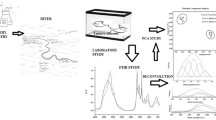Abstract
The purpose of this study is to examine the applicability of an infared spectroscopic methodology for the study of an environmental problem. The effect of cyanide concentrations on the biophysical conformation of the fish liver homogenate was determined by using an attenuated total reflectance (ATR)/Fourier nfrared (FT-IR) microspectroscopy. Alive male model fish, Tilapia Zillii, was used. The liver from fish was isolated and homogenized in pH 8.0 Tris buffer solution. The results indicate that the IR peak intensity increased markedly in the C–H stretching range (3000–2800 cm−1), ester C=O stretching of lipids (1743 cm−1) and carbohydrate bands (1195–950 cm−1), but decreased in the amide I at 1649 cm−1 and the free asymmetric stretching band of phosphate at 1261 cm−1 with the increase of KCN concentrations. The marked release of hepatic enzymes and glutathione into homogenate induced by cyanide might account for the higher IR spectral peak intensity of fish liver tissue after treatment with KCN. The cyanide was also found to induce the protein structure of fish liver homogenate from α-helical conformation to β-conformation.
Similar content being viewed by others
References
Albaum, H.G., Tepperman, J. and Bodansky, O. (1946). The in vivo inactivation by cyanide of cytochrome oxidase and its effects on high-energy phosphorous compounds in the barin. J. Biol. Chem. 64, 45-51.
Au, L.C., Lin, S.Y., Li, M.J. and Ho, C.J. (1999). pH-dependent secondary conformation of the peptide hormone leptin in different buffer solutions. Art. Cells Blood Subs. Immobil. Biotechnol. 27, 119-34.
Ballantyne, B. (1983). The influence of exposure route and species on the acute lethal toxicity and tissue concentrations of cyanide. In A. W. Hayes, R. C. Schnell and T. S. Miya (eds.) Developments in the Science and Practice of Toxicology, pp. 583-86. New York: Elsevier Science.
Ballantyne, B. (1987). Toxicology of cyanides. In B. Ballanytne and T. C. Marrs(eds) Clinical and Experimental Toxicology of Cyanides, pp. 41-126. Bristol, England: IOP Publishers, Ltd.
Buzaleh, A.M., Vazquez, E.S. and Batlle, A.M. (1990). Cyanide intoxication. II. The effects of systematic cyanide challenge on indicative toxicity parameters. Comp. Biochem. Physiol. C. 96, 177-80.
Jackson, M. and Mantsch, H.H. (1993). Biomembrane structure from FT-IR spectroscopy. Spectrochim. Acta Rev. 15, 53-69.
Jackson, M. and Mantsch, H.H. (1995). The use and misuse of FTIR spectroscopy in the determination of protein structure. Crit. Rev. Biochem. Mol. Biol. 30, 95-120.
Khandekar, J.D. and Edelman, H. (1979). Studies of amygdalin in rodents. JAMA 242, 169-71.
Leblanc, G.A. (1997). Basics of environmental toxicology. In E. Hodgson and P. E. Levi (eds) A Textbook of Modern Toxicology, pp. 389-405. East Norwalk, CT: Appleton & Lange.
Lee, D.C. and Chapman, D. (1986). Infrared spectroscopic studies of biomembranes and model membranes. Biosci. Rep. 6, 235-56.
Levi, P.E. (1997). Acute toxicity. In E. Hodgson and P. E. Levi (eds) A Textbook of Modern Toxicology, pp. 161-70, East Norwalk, CT: Appleton & Lange.
Lin, S.Y., Lee, S.M., Li, M.J. and Liang, R.C. (1997). Fourier transform infrared spectral evidences for protein conformational changes in immature cataractous human lens capsules accelerated by myopia and / or systemic hypertension. Spectrochim. Acta A. 53, 1507-13.
Lin, S.Y., Ho, C.J. and Li, M.J. (1998). Thermal stability and reversibility of secondary conformation of α-crystallin membrane during repeated heating process. Biophys. Chem. 74, 1-10.
Lin, S.Y., Ho, C.J. and Li, M.J. (1999). pH-dependent secondary conformation of bovine lens a-crystallin: ATR infrared spectroscopic study with second-derivative analysis. Graf. Arch. Clin. Exper. Ophthal. 237, 157-60.
Rigas, B., Morgello, S., Goldman, I.S. and Wong, P.T.T. (1990). Human colorectal cancers display abnormal Fourier-transform infrared spectra. Proc. Natl. Acad. Sci. USA 87, 8140-4.
Tinker, J.H. and Michenfelder, J.D. (1976). Sodium nitroprusside: pharmacology, toxicology and therapeutics. Anesthesiology 45, 340-54.
Wong, P.T.T., Wong, R.K., Caputo, T.A., Godwin, T.A. and Rigas, B. (1991). Infrared spectroscopy of exfoliated human cervical cells: Evidence of extensive structural changes during carcinogenesis. Proc. Natl. Acad. Sci. USA 88, 10988-92.
Wood, J.L. and Cooley, S.L. (1956). Detoxification of cyanide by cysteine. J. Biol. Chem. 218, 449-57.
Younes, M. and Strabelt, O. (1988). Cyanide-induced injury to the isolated perfused rat liver. Pharmacol. Toxicol. 63, 382-5.
Author information
Authors and Affiliations
Rights and permissions
About this article
Cite this article
Cheng, YD., Liu, TY. & Lin, SY. Cyanide-Induced Alterations to the Biophysical Conformations of the Isolated Fish Liver. Ecotoxicology 10, 71–77 (2001). https://doi.org/10.1023/A:1008962907875
Issue Date:
DOI: https://doi.org/10.1023/A:1008962907875




